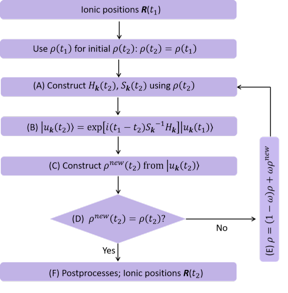Home > Press > Peering into precise ultrafast dynamics in matter
 |
| Flowchart of rt-TDDFT approach for evolution of coupled electronic and ionic systems. Here, we assume that the two subsystems have the same evolution time step
CREDIT Ultrafast Science |
Abstract:
A team of researchers from Beijing led by Prof. Dr. Sheng Meng has succeeded in developing predictive first-principles approaches for investigating precise ultrafast processes in matter. The method, named TDAP (time-dependent ab initio propagation), aims at providing robust dynamic simulations of light-induced, highly nonlinear phenomena which are at the atomic and molecular level and occur within a few femtosecond (10-15 sec) or even attosecond (10-18 sec). Fundamental interactions among different degrees of freedom can now be understood more precisely, purely based on quantum mechanical principles, according to the researchers. The results of the research have been published in the scientific journal Ultrafast Science and are expected to foster a variety of further developments in related scientific fields.
Peering into precise ultrafast dynamics in matter
Beijing, China | Posted on March 25th, 2022
The team has spent a decade of years working on extending first-principels theoretical methods into modelling dynamical responses of quantum materials to external fields (e.g., electric, magnetic and laser fields), which are of great interest in these days, but the detailed information remains rather limited. Especially, the generation and synthesis of intense ultrashort light pulses with a controlled electric field and associated phases provide a promising route to dynamically decouple and manipulate the microscopic interactions with an unprecedented time resolution. Therefore, the laser-induced nonequilibrium phenomena have attracted enumerated attention from a broad range of scientific fields.
The theoretical treatment of the time-dependent nonadiabatic phenomena induced by laser is a formidable challenge at many levels, ranging from the description of the excited states to the time propagation of the corresponding physical properties. In TDAP, time-domain quantum evolution of electronic states with the classical approximations of nuclear motions is treated concurrently, which has enabled real-time tracking of coupled electron-nuclear dynamics without having to resort to the perturbation theory. The use of numerical atomic orbital has provided flexibility and credibility to do high-accuracy, large-scale simulations in a wide range of quantum systems with a moderate computational cost.
The method has been applied to the exploration of strong field physics and decoding vast information underneath the experimentally detected signals. By comparing the theoretical and experimental results, the approaches have been demonstrated effective and efficient in treating ultrafast quantum dynamical processes involving complex interactions among photons, electrons and phonons under laser excitation conditions. The development of this method helps understand the excited state dynamics in the fields of photocatalysis, photovoltaic and optoelectronic device design, attosecond pulse synthesis and applications, etc.
####
For more information, please click here
Contacts:
Jiangbo She
Ultrafast Science
Copyright © Ultrafast Science
If you have a comment, please Contact us.
Issuers of news releases, not 7th Wave, Inc. or Nanotechnology Now, are solely responsible for the accuracy of the content.
News and information
![]()
Studying atomic structure of aluminum alloys for manufacturing modern aircraft March 25th, 2022
![]()
Hot spin quantum bits in silicon transistors March 25th, 2022
![]()
Snapshot measurement of single nanostructures circular dichroism March 25th, 2022
![]()
CEA and Startup C12 Join Forces to Develop Next-Generation Quantum Computers with Multi-Qubit Chips at Wafer Scale March 25th, 2022
Chemistry
![]()
Breaking the black box of catalytic reactions: Research offers new understanding of complex catalysis, advances catalyst design February 25th, 2022
![]()
Copper doping enables safer, cost-effective hydrogen peroxide production February 11th, 2022
![]()
Reusable Catalyst Makes CH Bond Oxidation Using Oxygen Easier and More Efficient February 11th, 2022
![]()
Void-confinement effect of nanoreactor promotes heterogeneous catalysis January 28th, 2022
Possible Futures
![]()
Studying atomic structure of aluminum alloys for manufacturing modern aircraft March 25th, 2022
![]()
Hot spin quantum bits in silicon transistors March 25th, 2022
![]()
Snapshot measurement of single nanostructures circular dichroism March 25th, 2022
![]()
Protective equipment with graphene nanotubes meets the strictest ESD safety standards March 25th, 2022
Optical computing/Photonic computing
![]()
Artificial neurons go quantum with photonic circuits: Quantum memristor as missing link between artificial intelligence and quantum computing March 25th, 2022
![]()
Ultra-compact integrated photonic device could lead to new optical technologies March 18th, 2022
![]()
Inorganic borophene liquid crystals: A superior new material for optoelectronic devices February 25th, 2022
![]()
Shining a light on synthetic dimensions January 28th, 2022
Discoveries
![]()
Re-jigged cathode recipe gives new hope to solid-state batteries for electric vehicles March 25th, 2022
![]()
Probing the inner workings of high-fidelity quantum processors: Scientists use gate set tomography to discover and validate a silicon qubit breakthrough March 25th, 2022
![]()
Hot spin quantum bits in silicon transistors March 25th, 2022
![]()
Snapshot measurement of single nanostructures circular dichroism March 25th, 2022
Announcements
![]()
Hot spin quantum bits in silicon transistors March 25th, 2022
![]()
Snapshot measurement of single nanostructures circular dichroism March 25th, 2022
![]()
Protective equipment with graphene nanotubes meets the strictest ESD safety standards March 25th, 2022
![]()
CEA and Startup C12 Join Forces to Develop Next-Generation Quantum Computers with Multi-Qubit Chips at Wafer Scale March 25th, 2022
Interviews/Book Reviews/Essays/Reports/Podcasts/Journals/White papers/Posters
![]()
Probing the inner workings of high-fidelity quantum processors: Scientists use gate set tomography to discover and validate a silicon qubit breakthrough March 25th, 2022
![]()
Studying atomic structure of aluminum alloys for manufacturing modern aircraft March 25th, 2022
![]()
Hot spin quantum bits in silicon transistors March 25th, 2022
Photonics/Optics/Lasers
![]()
Artificial neurons go quantum with photonic circuits: Quantum memristor as missing link between artificial intelligence and quantum computing March 25th, 2022
![]()
Ultra-compact integrated photonic device could lead to new optical technologies March 18th, 2022
Solar/Photovoltaic
![]()
Workhorse of photovoltaics combined with perovskite in tandem for the first time February 25th, 2022
![]()
Scientists enhance energy storage capacity of graphene supercapacitors via solar heating January 28th, 2022
![]()
Photon recycling The key to high-efficiency perovskite solar cells January 14th, 2022










